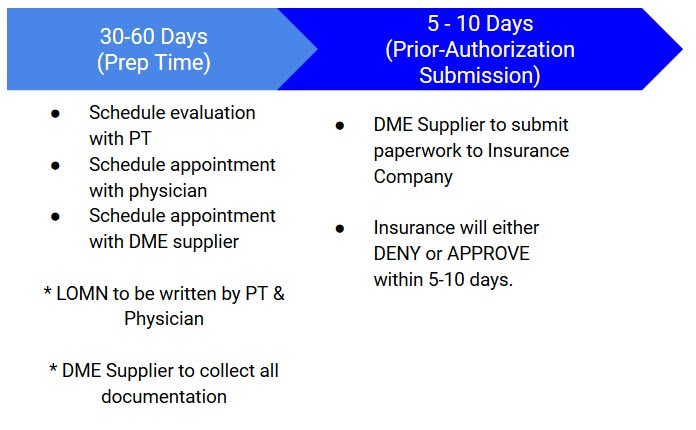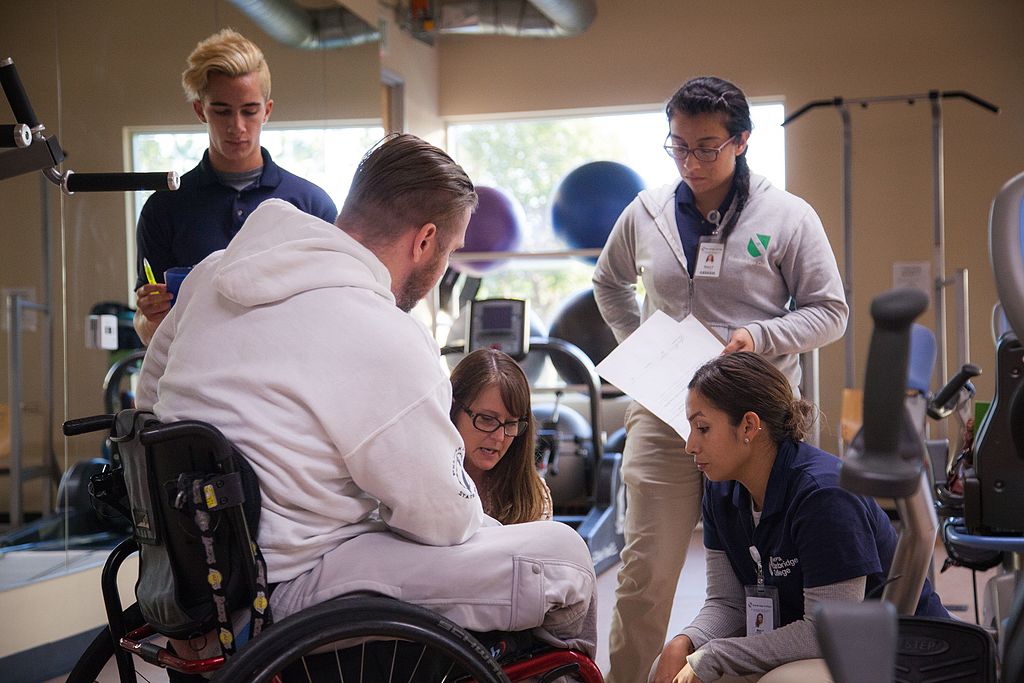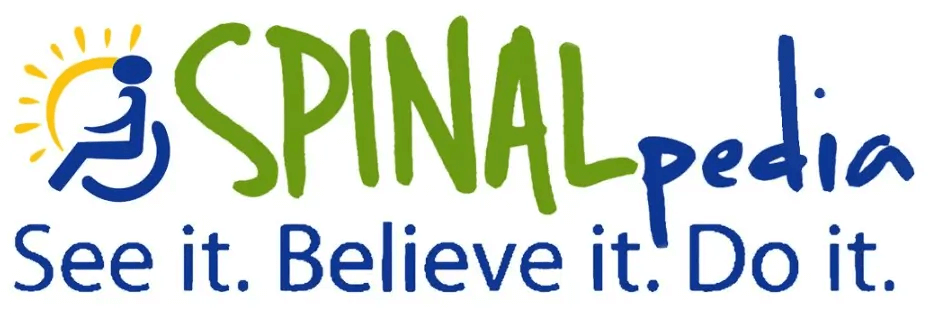Prior Authorization is the first step you need to take to verify if a piece of durable medical equipment you are looking to have approved by your health insurance carrier is covered under your plans policy.
It is a decision by your health insurer or plan that a healthcare service, treatment plan, prescription drug or piece of durable medical equipment is “medically necessary.” In most cases, your health insurance provider requires that you submit prior-authorization paperwork for certain services before you receive them; except in an emergency.
Prior-authorization is not a promise your health insurance provider will cover the cost of the equipment you are looking to have approved. It is just the first step in the approval process you need to go through.
Each step of the approval process requires its own strategy, which we will dive into “step-by-step”, in order to empower you to be your own advocate in getting the proper durable medical equipment approved that you need for “in the home” use only.
Below is an infographic of the whole process to get an idea on the overall process.
Your insurance company will be looking to see if the DME you are looking to have approved is medically necessary for your medical condition.
Tips & Tricks: Prior-Authorization Flow
Before you embark on the Prior-Authorization path with insurance it is important to understand what you’re trying to accomplish.

Each of the three steps mentioned above take time. You are going to need to have a little patience with respect to getting scheduled for your appointments, following up with your medical professionals about writing the evaluations and LOMN’s, etc.
This is why we suggest you give yourself about two months of prep time to get everything organized.
Tips & Tricks: Letters of Medical Necessity (LOMN) Advice
Your medical professionals will be responsible for justifying the equipment you are trying to have approved by your insurance company is “medically necessary” by writing an LOMN on your behalf.
While your medical professionals will understand the best technical medical wording for your insurance company, it’s helpful to work with them to make sure they understand your needs properly.
To help you better understand different expectations, requirements, and tips for assisting your medical professionals write the best LOMN’s for you – here are some examples:
There are dozens of other websites out there, but these should get you started and familiarized with proper templates, advice, and tips for LOMN’s.
Tip: While we should be able to trust our medical professionals, we, as patients, need to verify that they have our best interests at heart. Print out some of the above documents to review after reading your medical professionals LOMN’s to make sure they have all the necessary components for insurance justification.
NOTE: Your insurance company will likely justify these pieces of equipment as “accessories” and not “medically necessary.” Again, remember that you are trying to convince your insurance company “said” pieces of equipment are critical to your safety, quality of life, and help assist you in improving your Assisted Daily Living Activities.
Tips & Tricks: Patient Recommended Responsibilities
They will “Respect what you Inspect” as they say!

Source Wikimedia.org
When it comes to the justification of Durable Medical Equipment (DME) such as seat elevators, specialized wheelchairs, exercise equipment, specialized shower chairs, specialized mattresses & frames, etc. – your physical therapist (PT) is going to be your biggest advocate, and hold the most weight with your insurance company with respect to having this piece of DME approved.
It is important to note that if you are after a piece of DME such as a cardiovascular device, for example, then your physician or cardiologist will be your biggest advocate. You need to determine who your best advocate will be for any piece of DME you are trying to have approved.
When you decide on a piece of equipment you think is “medically necessary” for in-home use, the first step is to make an appointment with your PT for an evaluation of said piece of DME equipment.
Your PT will evaluate your physical needs and determine, with you, if said piece of DME is a good fit for you. Sometimes you will have to convince your PT why you need this piece of equipment.
TIPS
The more information you are armed with the better chance you have with success in having your insurance company approve your request.
Your Primary Care Physician (PCP) or other medical professional is another key relationship you are going to need to develop because they are going to write you a Letter of Medical Necessity (LOMN) in addition to your PT Evaluation.
More often than not you will be working with a PCP unless your DME is highly specialized for specific medical conditions relating to things such as kidney disease, cardiology issues, etc., in which case you will likely be working with a specialist.
Oftentimes, patients ask their PT to work directly with their PCPs because many PCPs are not only lacking in the understanding of specialized DME for specific disabilities, but may not fully understand the intricacies of your disability on the whole.
Your PCP should follow your PT’s lead with respect to justifying the “medical necessity” of a piece of DME.
It is IMPORTANT that LOMN letters and PT Evaluations line-up in the assessment of your condition, why you need this piece of DME, and how it will improve your quality of life for Assisted Daily Living Activities — Hence having both PT’s and PCP’s working together is advised.
TIPS
Your “in-network” DME Supplier relationship is an important one. Your DME supplier will generally be the one who submits the initial paperwork to your insurance company for Prior-Authorization. In some cases, your physician will submit all the paperwork, but not usually for DME.
Once you have your Letters of Medical Necessity (LOMN) and/or Evaluation from your PT and your PCP or other medical professional; your DME supplier will gather all the necessary paperwork to submit to your insurance company.
It’s important to note that not all DME suppliers are created equal. There are smaller local DME companies and large national DME companies such as Numotion. This is where paperwork, organization, signatures, etc. can get lost throughout the winding process of submitting Prior- Authorization paperwork to your insurance company.
Tips & Tricks: DME Provider – “In-Network”
It’s really important that you first contact your health insurance provider or go to your online portal to make sure your durable medical provider is “in-network.”
If they are not and they are “out-of-network,” then you are going to be left with a pretty hefty financial responsibility because any company not contracted with your insurance company will make you responsible for payment.
Smaller and locally run DME companies are easier to work with because you are able to build a relationship with them and they know you. This is great because it ensures they will fight for you and notify you if they need any further information from you or your medical professionals.
The challenge with smaller DME companies is that they don’t always have a large selection of the DME you may require.
It’s a pretty simple solution to figure out by having a conversation with them and ensuring that they are willing to work with you on whatever piece of DME you would like. Oftentimes, if you have a great relationship with them, they will even go above and beyond to become distributors of certain pieces of equipment for you too.
Larger national DME companies definitely have more clout with respect understanding how to navigate within the insurance approval, denial, and appeals realm. They also have a larger selection of DME for you to choose from because they are simply a larger dealer.
The challenge you run into with these larger companies, as with any large company, is that you can become just a number and oftentimes get lost in the mix of other patients. It is a great idea to try and build a personal relationship with one or two people within the company in your area. If you are unable to do this then you NEED to be your own self advocate.
What does this mean?
Follow up in a word. It’s important to make sure you understand who all the players are in the game such as your PT, PCP’s, and DME suppliers, so you can help coordinate all the paperwork simultaneously to make sure the right documentation is getting submitted to insurance.
If you are not sure what all the right paperwork is to be submitted, just ask. Ask an employee in the insurance department of your DME company to walk you through the process step-by-step, take notes, and ask to see the documentation prior to submitting everything to insurance.
It’s all too common for Prior-Authorizations to get denied simply because a signature was left off, a medical code was not inserted properly, etc.
TIPS

Documents to be submitted:
All these documents will be faxed in by either your DME supplier or your physician. Typically with DME, it is your DME supplier who will organize and fax in all the documents.
Tips & Tricks: Expectations
If you are trying to get approved for a piece of medical equipment that is deemed an “accessory” as defined by your health insurance company, but you are trying to convince them that said piece of equipment is “medically necessary,” then don’t be surprised if you get denied during Prior-Authorization.
Don’t get discouraged!
“NO” during the Prior-Authorization stage of the approval process is really just a starting negotiation point. It’s pretty standard for health insurance companies to deny you right off the bat, but this is what the appeals process is for, which we dive deep into in the next section.
Make sure to keep all of your paperwork organized because when you do move on to the appeals process it is a little bit more involved, and requires some serious organization on your part.
DME is any equipment that provides therapeutic benefits to a patient in need because of certain medical conditions and/or illnesses.
DME equipment under Medicare guidelines must meet these criteria
DME includes, but is not limited to:
A LOMN is a carefully written letter by your physician and/or physical therapist stating why the patient needs a specific piece of equipment, test, treatment, or medication. Your medical professional will diagnose your medical condition, include pertinent medical history, outline why said piece of DME equipment is medically necessary for your condition even if your insurance provider deems certain DME equipment as an accessory and not “medically necessary” under your insurance plan’s policy.
Please refer to Tips & Tricks for LOMN patient strategies to write the most effective lette
In-network providers are healthcare providers who are contracted by an insurance company, and provide medical care to those enrolled in plans offered by that insurance company.
The providers in the health insurance plans network are called in-network providers. Every insurance plan provides a list of in-network providers on their patient portals.
A provider who is not contracted with your insurance company for reimbursement at a negotiated rate.
A durable medical supplier is any company selling medical equipment used in the home to aid in a better quality of living.
Durable medical suppliers offer DME equipment such as wheelchairs, shower chairs, canes, incontinence products, colostomy products, etc.
Under your medical and prescription drug plans, certain medications, services, and equipment may need approval from your health insurance carrier before they are covered.
Prior to receiving any service, product, or medication from an insurance company your physician and other medical professionals will write a letter of medical necessity for the patient justifying why a product or service is medically necessary for the patient’s medical condition.
An explanation of benefits is a statement from your health insurance plan describing what costs it will cover for medical care or products the patient is eligible to receive.
The EOB is generated when your provider submits a claim for the services you have received.
You can find your explanation of benefits on your Health Providers Patient Portal and/or they send you a booklet each year when enrolling in a health plan.
Insurance is regulated at the state level, so each state has its own insurance department to help you. Each department is tasked with one overarching duty of regulating insurance for the protection of consumers.
The DOI serves several roles including licensing insurance companies and agents, regulating insurance policies and rates, reviewing insurance company practices, and serving consumers through education and complaint resolution

SPINALpedia
